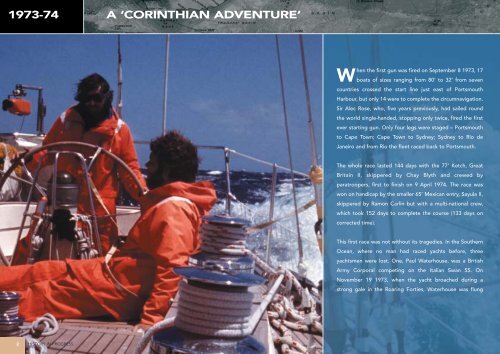Volvo Ocean Race: Overview, Marketing, History
Volvo Ocean Race: Overview, Marketing, History
Volvo Ocean Race: Overview, Marketing, History
You also want an ePaper? Increase the reach of your titles
YUMPU automatically turns print PDFs into web optimized ePapers that Google loves.
1973-74 A ‘CORINTHIAN ADVENTURE’<br />
2 HISTORY IN PROGRESS<br />
When the first gun was fired on September 8 1973, 17<br />
boats of sizes ranging from 80’ to 32’ from seven<br />
countries crossed the start line just east of Portsmouth<br />
Harbour, but only 14 were to complete the circumnavigation.<br />
Sir Alec Rose, who, five years previously, had sailed round<br />
the world single-handed, stopping only twice, fired the first<br />
ever starting gun. Only four legs were staged – Portsmouth<br />
to Cape Town; Cape Town to Sydney; Sydney to Rio de<br />
Janeiro and from Rio the fleet raced back to Portsmouth.<br />
The whole race lasted 144 days with the 77’ Ketch, Great<br />
Britain II, skippered by Chay Blyth and crewed by<br />
paratroopers, first to finish on 9 April 1974. The race was<br />
won on handicap by the smaller 65’ Mexican entry, Sayula II,<br />
skippered by Ramon Carlin but with a multi-national crew,<br />
which took 152 days to complete the course (133 days on<br />
corrected time).<br />
This first race was not without its tragedies. In the Southern<br />
<strong>Ocean</strong>, where no man had raced yachts before, three<br />
yachtsmen were lost. One, Paul Waterhouse, was a British<br />
Army Corporal competing on the Italian Swan 55. On<br />
November 19 1973, when the yacht broached during a<br />
strong gale in the Roaring Forties, Waterhouse was flung




